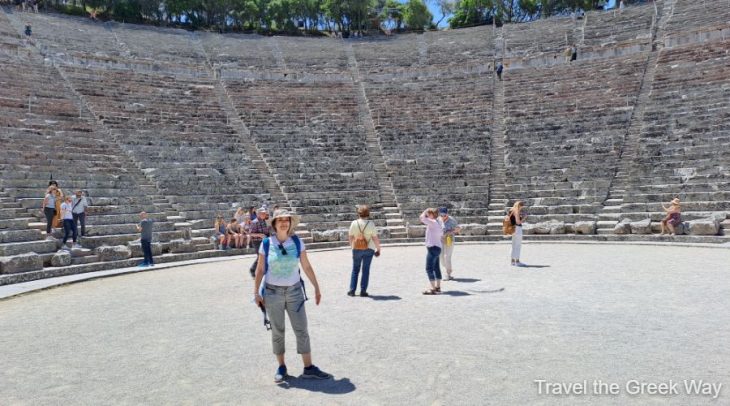
Word of the Day: Proscenium
Today’s word of the day, courtesy of the New York Times, is proscenium. According to the Times, the proscenium is the “part of a modern theater stage between the curtain and the orchestra (i.e., in front of the curtain)” or “the wall that separates the stage from the auditorium in a modern theater,” although such a wall, were it a complete wall, would make it impossible for the audience to see the stage. Thus, there is usually a big opening in said wall, and theater people refer to what’s left of the wall as the proscenium arch.
The word seems to have entered the language “c. 1600 … from Latin proscaenium, from Greek proskēnion ‘the space in front of the scenery,’ also ‘entrance of a tent,’ from pro ‘in front, before’ (see pro-) + skēnē ‘stage, tent, booth’ (see scene). Modern sense of ‘space between the curtain and the orchestra’ (often including the curtain and its framework) is attested from 1807. Hence, figuratively, ‘foreground, front’ (1640s)” (https://www.etymonline.com/search?q=proscenium).
To understand how the proscenium became a big arch, one would benefit from knowing a little bit of theater history. For centuries upon centuries, the performers in a theater were pushed out away from the scenery, into the audience. If you can remember the pictures of Shakespeare’s Globe Theater, you will know what I’m talking about. But as theatrical productions moved indoors, and as the plays themselves became more realistic, especially in the nineteenth century, the action was brought back behind the proscenium arch. We talk about the fourth wall in theater, the invisible wall that let’s the audience see what is going on behind that wall amidst the scenery. And the modern inventions of movies and television (not to mention things like YouTube) have made that fourth wall even more obvious.
Of course, even in modern theaters and movies and television, characters sometimes engage or try to engage directly with the audience; we call this, “breaking the fourth wall.” Some recent examples include Ferris Bueller’s Day Off, the old Nickolodeon show Clarissa Explains It All, and even the original Magnum, PI. It can be a clever device, as long as it is not used too often. Interactive theater goes a step further and incorporates the audience into the action, such as Ayn Rand’s The Night of January 16th in which audience members become the jury, making the outcome of the play different depending upon those audience members.
The theater of ancient Greece (where some say theater began) did project the action out into the audience, placing the action in front of the scenery. One can see this in the most famous example of the theater of ancient Greece, the theater at Epidaurus.
According to Ethel Dilouambaka (https://theculturetrip.com/europe/greece/articles/a-very-brief-history-of-epidaurus-ancient-theater-greece), “the theater of Epidaurus was built in the 4th century BC by Polykleitos the Younger.” That makes the theater over 2300 years old, and yet it is still used today. The theater sits around 12,000 people, but the acoustics are such that people at the top of the seating area (the house is raked or sloped rather than the stage, as in most modern theaters) can hear performers on the stage even though the performers are not using microphones. I have never myself been to Greece, but a close personal friend toured it years ago, and he told me that the tour group he was with tried it out and found it to be true.
According to Evgenia Mataragka (https://travelthegreekway.com/asklepion-sanctuary-in-epidavros/), who was apparently at the site earlier this year, the theater “is part of the large archaeological site of Asklepios sanctuary in the Peloponnese in Greece,” a place which also features the “Asklepios Sanctuary, a UNESCO-listed monument, was the most important religious and healing center in ancient Greek and Roman times. The sanctuary, built between 365 and 335 BCE, had developed pioneer methods for healing and treating their patients.” She calls it the “birthplace of modern medicine.”
Mataragka also says, and I believe her, that the city of Athens “organizes spectacular theatrical and musical performances that you can attend,” and since Athens is only about 90 miles away, one can get there pretty easily by car. The site is east of the village of Nafplio, for those of you who read Ty Hutchinson. And she says that the price to visit the site is reasonable and that you can see everything in just a couple of hours, though you could spend longer.
The image today is Mataragka and other tourists visiting the theater at Epidaurus. Check out her website. It makes the idea of travelling to Greece seem appealing.